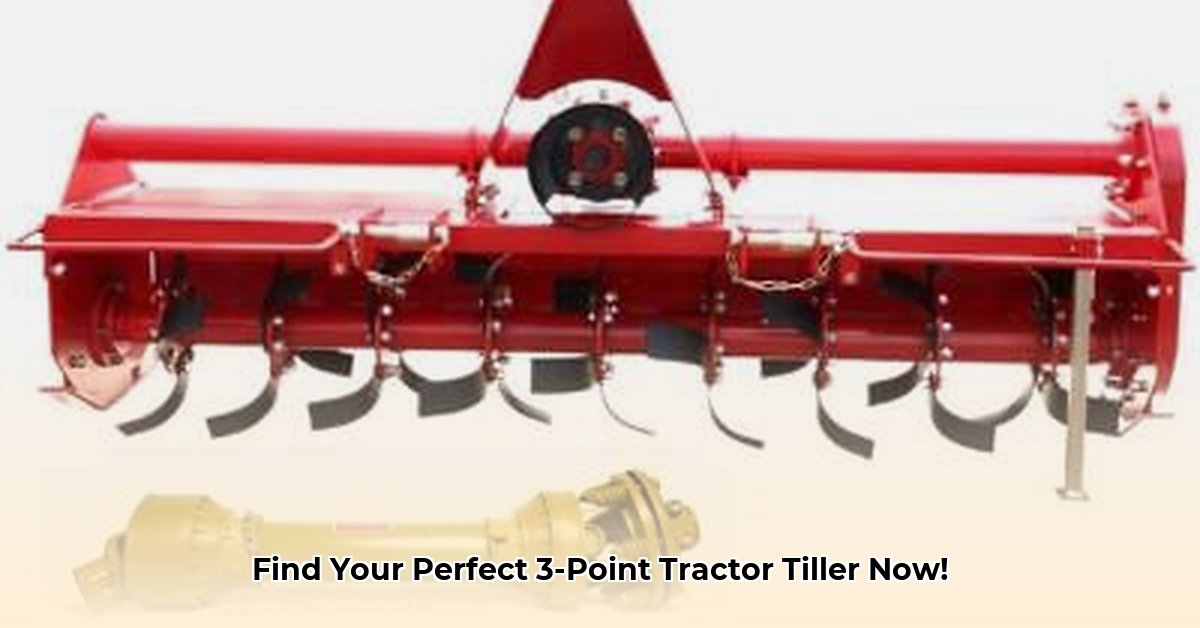
Choosing the right 3-point tractor tiller is crucial for efficient and sustainable farming. This comprehensive guide will help you navigate the selection process, covering key factors, tiller types, model comparisons, and essential maintenance tips. Whether you're a seasoned farmer or a newcomer, this guide empowers you to make an informed decision. For even more in-depth information, check out this helpful resource.
Choosing Your Perfect 3-Point Tractor Tiller
Selecting a 3-point tractor tiller requires careful consideration of several factors. This section acts as your personalized buying checklist, guiding you towards the perfect match for your needs and budget.
Key Factors to Consider
Several critical aspects influence your tiller choice. Let's break down each factor with actionable insights:
Tilling Depth and Width: How deep do you need to till? Deeper tillage improves aeration and drainage, but requires more horsepower. Width affects coverage per pass; wider tillers are faster but demand more power. Consider your soil type and crop requirements when determining optimal depth and width. A chart comparing various depths and widths with suggested horsepower would be beneficial here.
Horsepower Requirements: Crucially, your tractor must possess sufficient horsepower for the chosen tiller. Underpowering leads to poor performance and potential equipment damage. Matching your tiller's horsepower needs to your tractor's capabilities is essential, preventing both underperformance and unnecessary expense. Consult your tractor's manual for its PTO (Power Take-Off) horsepower.
Soil Type: Soil type significantly impacts tiller selection. Clay soils necessitate robust tillers, while sandy soils require less powerful options. Rocky soils demand tillers built to withstand impacts. Understanding your soil's characteristics is paramount.
Farm Size and Efficiency: The size of your operation influences tiller size. Small gardens benefit from smaller, maneuverable tillers, while large farms require wider, more powerful models for efficient coverage. Consider both the acreage and the type of crops you grow. Larger farms benefit from wider tiller coverage.
Maintenance Ease and Longevity: Easy maintenance is key for minimizing downtime. Look for tillers with easily accessible components for routine checks and repairs. Consider the frequency of lubrication and the availability of replacement parts. What is the average lifespan of the tiller models you're considering?
Warranty: A solid warranty demonstrates manufacturer confidence and provides protection against defects. It offers peace of mind and safeguards your investment. Compare warranty durations and coverage among different models.
Features: Features such as reverse rotation (RTNR) aid in clearing clogs and tackling compacted soil. Consider any extra features that enhance efficiency or operation. How will additional accessories affect your overall productivity?
Types of 3-Point Tractor Tillers
While rotary tillers are the most common, other specialized types exist. The choice depends heavily on factors listed above.
Rotary Tillers: These use rotating tines to break up and mix soil, offering versatility for various soil conditions. They are the workhorses of the tilling world.
Specialty Tillers: Specialized tillers cater to specific needs and soil types.
Model Comparisons
Direct comparisons are complicated by the lack of standardized testing data. However, we can analyze available information on popular models such as King Kutter and Farmer Helper. Note all data is gathered and analyzed from readily available information and might not reflect the entire performance spectrum for particular models.
| Model | Strengths | Weaknesses | Best Suited For |
|---|---|---|---|
| King Kutter | Robust build, extensive options | Can be expensive, detailed specs sometimes scarce | Larger farms, tough conditions |
| Farmer Helper | Budget-friendly, suitable for most tasks | Might not last as long as higher-end models | Smaller operations, less demanding soil conditions |
(Note: This comparison is illustrative. Always consult manufacturer specifications and independent reviews for comprehensive information.)
Maintenance for Optimal Performance
Regular maintenance is vital for extending the life and ensuring the efficient performance of your tiller.
Regular Inspections: Regularly inspect for wear and tear on tines, gearbox, and other components. Replace damaged parts promptly.
Lubrication: Keep moving parts well-lubricated, following the manufacturer's recommendations.
Proper Storage: Store your tiller properly when not in use, protecting it from the elements.
Conclusion: Making the Right Choice
Choosing the best 3-point tractor tiller is a multi-faceted decision. This guide lays out the key aspects to consider, helping you match your needs to the right tiller for maximum efficiency and longevity. Remember: thorough research and careful consideration of your specific farming needs are crucial for making the best purchase decision.